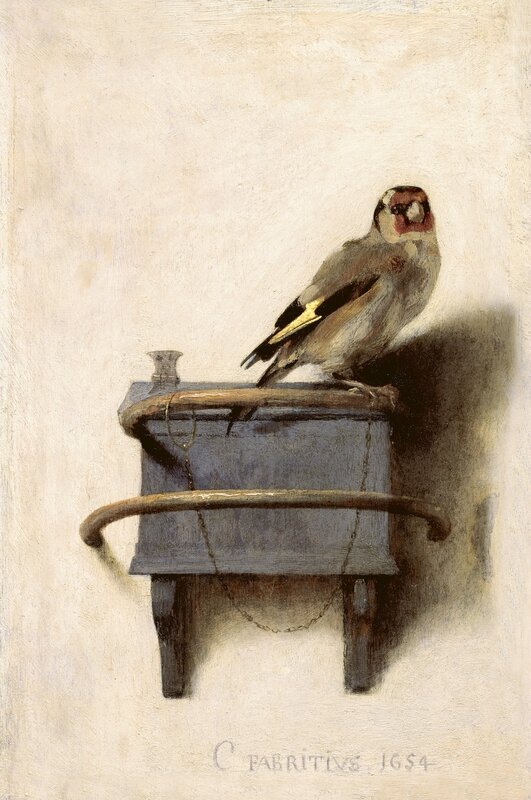Masterpiece from the Golden Age of Dutch painting visits Scottish National Gallery
Carel Fabritius, The Goldfinch, 1654. Oil on panel, 33.5 x 22.8 cm. Collection: Mauritshuis, The Hague © Mauritshuis
EDINBURGH.- A beautiful and mysterious masterpiece from the Golden Age of Dutch painting, which inspired a Pulitzer Prize-winning novel by the US publishing sensation Donna Tartt, made a flying visit to the Scottish National Gallery in Edinburgh this autumn. The Goldfinch, which was painted in 1654 by Carel Fabritius, already enjoyed international renown before the intense interest surrounding Tartt’s 2014 novel of the same name propelled this mesmerising painting into the limelight, bringing it to the attention of Holywood producers, who now hope to adapt Tartt's book for the big screen.
One of only a handful of works by Fabritius known to exist, The Goldfinch traveled to the SNG from its home in the Royal Picture Gallery Mauritshuis, in The Hague, for six weeks only, from 4 November to 18 December this year. The painting has never before been shown in Scotland, and has only been exhibited in the UK on a handful of occasions. When it was shown at the Frick Collection in New York in 2014, it was seen by a record-breaking 200,000 people (many of whom happily endured long queues in sub-zero temperatures).
Carel Fabritius (1622-1654) is often seen as the link between two giants of Dutch painting: Rembrandt van Rijn (1609-69), in whose workshop he was a star pupil and Johannes Vermeer (1632-75), on whose work he had a considerable influence. An artist of remarkable skill, Fabritius was tragically killed at the age of 32, when a gunpowder store exploded, destroying large parts of the city of Delft and killing hundreds of its residents. It is presumed that much of Fabritius’s work was lost in the explosion, and only around a dozen of his paintings survive. Among these The Goldfinch, which was painted in the year he died, is considered by many to be his masterpiece.
At the time that Fabritius painted this tiny ‘portrait’ of a goldfinch (the painting measures a mere 33.5 x 22.8 cm), these little birds were popular pets, renowned for their ability to learn tricks, such as pulling up their drinking water in a tiny thimble-sized pail from a hidden glass below. In Dutch paintings of the period, they might be read as a symbol of resourcefulness and dexterity, or perhaps of captive love, but Fabritius's Goldfinch seems to fall outside such traditions, and its meaning is more elusive. Here there are no props or tricks, just a single bird, painted with extraordinary realism, perched on its feeding-box, its leg attached to a wooden hoop by a slender metal chain.
If the image itself is unique in the art of the period, the original function of The Goldfinch, which was painted in oil on wooden panel, is also shrouded in mystery. There have been various speculations that it might have been intended as a shop sign, part of a piece of furniture or a cover for a box containing another painting. What seems certain however is that Fabritius intended to create a vivid illusion – one that might literally 'fool the eye' into reading the image as a living bird rather than a representation (an effect often referred to as 'trompe l'oeuil').
Fabritius's goldfinch is life-sized, and the shallow box on which it sits is portrayed against a small patch of flat wall, viewed head-on and artfully painted to suggest areas of flaking plaster. The shadows cast by the box and by the bird itself are consistent with a low view point and it may be that the painting was intended to hang high on a wall, helping to create the conditions under which an observer might be wholly taken in by it.
Yet this perfect illusionism is undermined by the way in which Fabritius has painted the little bird itself – with swift and clearly distinguishable brushstrokes. Whatever pains he took to create a convincingly lifelike image, the artist did nothing to disguise the fact that he has somehow conjured the essence of a living, breathing creature merely by the skilful placement of a series of abstract marks comprised of pigment and oil.
Perhaps it is this paradox that has given The Goldfinch its power to fascinate and to inspire. Donna Tartt’s 800-page novel is an epic story of love, loss and obsession. In her fictionalised account The Goldfinch is removed from the debris of a terrorist explosion in New York’s Metropolitan Museum by a survivor, a teenage boy who loses his devoted mother in the blast. Over the course of the novel, his secret and illicit possession of this humble, but singularly beautiful painting gives the main character his only anchor in a chaotic, dislocated and grief-haunted life.
Speaking of the display, Michael Clarke, Director of the Scottish National Gallery said, “We are delighted to present Carel Fabritius’s iconic The Goldfinch in Scotland for the first time. Hugely popular since it inspired Donna Tartt’s bestselling novel, this is a very rare opportunity for art and literature lovers alike to come face to face with one of the most compelling paintings in Western art".
Carel Fabritius (1622-54), The Goldfinch, 1654. Oil on panel, 33.5 x 22.8 cm. Collection: Mauritshuis, The Hague.

/https%3A%2F%2Fprofilepics.canalblog.com%2Fprofilepics%2F1%2F0%2F100183.jpg)
/https%3A%2F%2Fstorage.canalblog.com%2F03%2F02%2F119589%2F96711876_o.jpg)
/https%3A%2F%2Fstorage.canalblog.com%2F11%2F31%2F119589%2F94773502_o.jpg)
/https%3A%2F%2Fstorage.canalblog.com%2F20%2F83%2F119589%2F94772815_o.jpg)
/https%3A%2F%2Fstorage.canalblog.com%2F26%2F72%2F119589%2F75604929_o.jpg)
/https%3A%2F%2Fstorage.canalblog.com%2F59%2F60%2F119589%2F26458628_o.jpg)




/image%2F1371349%2F20240321%2Fob_0f526c_rembrandt-arms-akimbo.jpg)
/http%3A%2F%2Fstorage.canalblog.com%2F82%2F58%2F119589%2F72341811_o.jpeg)
/http%3A%2F%2Fstorage.canalblog.com%2F32%2F06%2F119589%2F109791691_o.jpg)
/image%2F1371349%2F20240423%2Fob_b2fe42_telechargement-9.jpg)